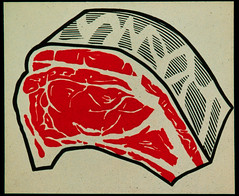After brewing, I went to get some produce and to search for a bottle of Dubbel. Unfortunately, I could only find Westmalle Tripel and not the Dubbel but somehow I knew that I’d make do. I had a small pork loin roast that I brined but needed to figure out what else to do with it. There have been a lot of great spring onions (even this late), so I picked a bunch of them to roast on the grill as well as some remarkable fennel. I wanted some kind of grain pilaf and opted to go with spelt, which I had never cooked but had in fact brewed with. I ground up some fennel seeds, black peppercorns and mixed those with salt and dried mustard to make a crust for the pork roast. I coated the roast in olive oil and then crusted it with the spice blend and roasted it in the grill along with the spring onions and some carrots. I tossed the onions and carrots with a basil sherry vinaigrette. The pilaf was just onions, garlic, spelt and chicken stock. The spelt pilaf was a bit over salty, but the bite of the sherry vinaigrette helped to cut that somewhat. I had a Monchshot Schwarzbier during the prep work and it continues to be one of my favorite beers. I’ve become more of a hop head through the years, but every time I have great German beer, I realize that the defining and uniting element of most German beers is a real purity of malt flavor. German beers seem more malt driven than any other nation’s beers. You can taste it from the lightest pilsner to the biggest doppelbocks. The Monchshof is no exception. The malt is rich and deep with a long lingering finish. Kostritzer may have the reputation of being “the” schwarzbier, but Monchshof, to my rtatses, is much richer and doesn’t have the slight black malt bite that Kostritzer sometimes seems to have. Overall, it was an exceptional beer and ranks as one of the world’s best beers.
With dinner, I had the Westmalle Tripel. Westmalle is my favorite Tripel and is the benchmark that I use to judge all the others (even though they’re all slightly different). The aroma is all candy, spices and the distinctive orange note that Westmalle’s yeast seems to impart. It’s highly carbonated which helps hide its 9.5% alcohol content. It was dry enough to cut through the overly salty pilaf and the spice was a nice compliment to the spice crust on the pork. The sweetness of the roast onions and carrots was offset by the sherry vinaigrette and it was a great match with the Tripel as well. Tripel seems to work well with roasted pork and chicken. It has enough heft to standup to the food, but also has enough carbonation to cut through the other flavors. The spicy and sometimes herbal aromas also compliment a variety of preparations, although I normally avoid tripel with very spicy foods, like Mexican or Thai. Good Tripel, like Westmalle, has a certain elegance which seems to get lost with overly spicy food. (One of the worst beer and food combos I ever had was Tripel Karmeliet with pork braised in salsa verde. The spices in the salsa verde fought with the spiciness of the beer and created quite a trainwreck.) Save your Tripels for roasted bistro-type chicken and pork dishes, but break the Dubbel or other dark abbey beers out for the braised short ribs or lamb shanks.
Monday, July 16, 2007
Tripel and roast pork
Posted by
Bill
at
10:31 AM
![]()
![]()
Labels: monchshof schwarzbier, westmalle tripel
Subscribe to:
Post Comments (Atom)

No comments:
Post a Comment